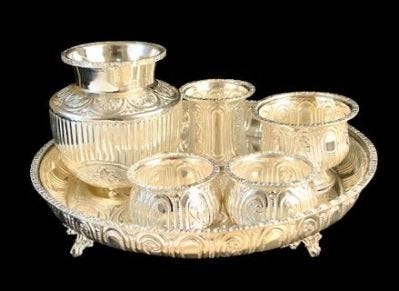Things You Must Know About Indian Silver Pooja Items

Religious gatherings in a Hindu household are common in India. They are considered the integral component in a home and are performed almost daily. These poojas are done in front of a home temple where a Hindu god resides, like Ganesha, Lakshmi, Radha-Krishna or anyone else. The Indian silver pooja items are the most common accessories that are used during the pooja.
The tradition of performing poojas at home has been dating back centuries when people used to call upon their gods to bless their home, health and business. This devotion has not lost its touch in India. Pooja has many different parts, and in each one, a certain ritual is performed. The accessories like silver glass, plate, diya are used to perform rituals like the aarti of God, as well as home. Silver is considered pure metal and that’s why it is more popular than any other metal in Indian homes.
Different types of Indian Silver Pooja Items
Silver Deepam or Diya
The silver deepam or Kundulu can be found in almost every Hindu home and public temple in India. These are smallholders that hold oil and wicks. The burning of this diya or deepam is considered sacred during any religious ritual, like a puja. The light from the diya represents the movement of darkness to light, evil to divine and bad to good. It is a belief that burning the diya in homes where any Hindu god or goddess resides, blesses us with their love and blessings.
Silver Pooja Plate
If there’s anything an Indian house will have, it’s a silver plate. Their primary usages are dinner plates, but they are used in pujas to hold multiple items in a Hindu household. This is also an excellent gift choice for couples who’re newly-wed. The silver pooja plate designs can be simple and straightforward, or it could have attached small bowls with it. These bowls are specifically designed to hold items like flowers, coconuts, bells, water, Diya, and a few other puja items.
Silver Kalash or Pot or Lota
The Kalash or ‘pot’ is used to hold water when doing puja. It depicts various forms of goddesses in different pujas. The silver Kalash design represents material things. It is considered a container of fertility — the womb of a woman, and earth which nurtures life.
Silver Kalash with coconut, cash crop, leaf of betel; represents prosperity and power. And water in the pot is the symbol of the life-giving ability of nature.
Silver Agarbatti Stand
No puja in an Indian household is complete without the use of Agarbattis or incense sticks. These purify the air and replace the foul smell (if any) with a fresh aroma. The agarbatti stand is a thick metal rod with holes all around to keep agarbattis in place. There are multiple designs and sizes available, depending on how many incense sticks you use.